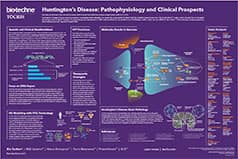Glutamate (EAAT) Transporters
Glutamate transporters, also known as excitatory amino acid transporters (EAATs), are sodium- and potassium-dependent members of the solute carrier family 6 (SLC1), widely distributed throughout the brain. There are five EAAT subtypes, each with a specific distribution.
Glutamate Transporter Modulators |
|
|---|---|
| Cat. No. | Product Name / Activity |
| 6578 | GT 949 |
| Potent and selective positive allosteric modulator of EAAT2 | |
Glutamate Transporter Inhibitors |
|
| Cat. No. | Product Name / Activity |
| 3697 | 7-Chlorokynurenic acid sodium salt |
| Potent competitive inhibitor of L-glutamate uptake. Sodium salt of 7-Chlorokynurenic acid (Cat. No. 0237) | |
| 0237 | 7-Chlorokynurenic acid |
| Potent competitive inhibitor of L-glutamate uptake | |
| 0111 | Dihydrokainic acid |
| EAAT2 (GLT-1)-selective non-transportable inhibitor of L-glutamate and L-aspartate uptake | |
| 0845 | Evans Blue tetrasodium salt |
| Potent inhibitor of L-glutamate uptake into synaptic vesicles; also non-NMDA iGluR antagonist; P2X antagonist | |
| 0183 | L-(-)-threo-3-Hydroxyaspartic acid |
| Transportable EAAT1-4 inhibitor/non-transportable EAAT5 inhibitor | |
| 0298 | L-trans-2,4-PDC |
| Transportable EAAT1-4 inhibitor/non-transportable EAAT5 inhibitor | |
| 1223 | DL-TBOA |
| Selective non-transportable inhibitor of EAATs | |
| 2532 | TFB-TBOA |
| Potent and selective EAAT1 and EAAT2 blocker | |
| 3490 | UCPH 101 |
| Selective non-substrate EAAT1 inhibitor | |
| 2652 | WAY 213613 |
| Potent, non-substrate EAAT2 inhibitor | |
Glutamate transporters, also known as excitatory amino acid transporters (EAATs), are sodium- and potassium-dependent members of the solute carrier family 6 (SLC1) found widely distributed throughout the brain. There are five EAAT subtypes, each with a specific primary distribution; EAAT1 (cerebellar glia), EAAT2 (forebrain glia), EAAT3 (cortical neurons), EAAT4 (cerebellar Purkinje neurons) and EAAT5 (retina).
Functions of glutamate transporters include regulation of excitatory neurotransmission, maintenance of low ambient extracellular glutamate concentrations (protects against neurotoxicity) and providing glutamate for metabolism through the glutamate-glutamine cycle.
Overactivity of glutamate transporters has been implicated in the pathophysiology of schizophrenia and other mental illnesses, whilst underactivity is seen in ischemia and traumatic brain injury.
External sources of pharmacological information for Glutamate (EAAT) Transporters :
Literature for Glutamate (EAAT) Transporters
Tocris offers the following scientific literature for Glutamate (EAAT) Transporters to showcase our products. We invite you to request* your copy today!
*Please note that Tocris will only send literature to established scientific business / institute addresses.
Huntington's Disease Poster
Huntington's disease (HD) is a severe monogenic neurodegenerative disorder, which is characterized by the prevalent loss of GABAergic medium spiny neurons (MSN) in the striatum. This poster summarizes the effects of mutant huntingtin aggregation implicated in the pathology of HD, as well as highlighting the use of iPSCs for HD modeling.
Glutamate Transporter Gene Data
| Gene | Species | Gene Symbol | Gene Accession No. | Protein Accession No. |
|---|---|---|---|---|
| EAAT1 | Human | SLC1A3 | NM_004172 | P43003 |
| Mouse | Slc1a3 | NM_148938 | P56564 | |
| Rat | Slc1a3 | NM_019225 | P24942 | |
| EAAT2 | Human | SLC1A2 | NM_004171 | P43004 |
| Mouse | Slc1a2 | NM_001077514 | P43006 | |
| Rat | Slc1a2 | NM_017215 | Q91ZA9 | |
| EAAT3 | Human | SLC1A1 | NM_004170 | P43005 |
| Mouse | Slc1a1 | NM_009199 | P51906 | |
| Rat | Slc1a1 | NM_013032 | P51907 | |
| EAAT4 | Human | SLC1A6 | NM_005071 | P48664 |
| Mouse | Slc1a6 | NM_009200 | O35544 | |
| Rat | Slc1a6 | NM_032065 | O35921 | |
| EAAT5 | Human | SLC1A7 | NM_006671 | O00341 |
| Mouse | Slc1a7 | NM_146255 | Q8JZR4 | |
| Rat | Slc1a7 | NM_001108973 | XP_345560 |
Properties of Glutamate Transporters
| Subtype | EAAT1 | EAAT2 | EAAT3 | EAAT4 | EAAT5 |
|---|
| Primary Distribution | Cerebellar glia | Forebrain glia | Cortical neurons | Cerebellar Purkinje neurons | Retina |
| Selected Inhibitors | Ki (μM) | ||||
| cis-ACBD (0271)1 | 170 | 680 | 230 | - | - |
| Dihydrokainic acid (0111) | > 30002 | 232 | > 30002 | - | - |
| L-(-)-threo-3-Hydroxyaspartic acid (0183)1 | 11 | 19 | 14 | - | - |
| (±)-threo-3-Methylglutamic acid (0811) | 1600 (IC50)3 | 90 (IC50)3 | 1080 (IC50)3 | 109 (IC50)3 | - |
| L-trans-2,4-PDC (0298) | 791 | 81 | 611 | - | - |
| DL-TBOA (1223) | 70 (IC50)4 | 6 (IC50)4 | 6 (IC50)4 | 4.45 | 3.25 |
References
- Jensen and Bauner-Osborne (2004) Pharmacological characterization of human excitatory amino acid transporters EAAT1, EAAT2 and EAAT3 in a fluorescense-based membrane potential assay. Biochem.Pharmacol. 67 2115.
- Arriza et al (1994) Functional comparisons of three glutamate transporter subtypes cloned from human motor cortex. J.Neurosci. 14 5559.
- Eliasof et al (2001) Pharmacological characterization of threo-3-methylglutamic acid with excitatory amino acid transporters in native and recombinant systems. J.Neurochem. 77 550.
- Jabaudon et al (1999) Inhibition of uptake unmasks rapid extracellular turnover of glutamate of nonvesicular origin. Proc.Natl.Acad.Sci.USA 96 8733.
- Shigeri et al (2001) Effects of threo-β-hydroxyaspartate derivatives on excitatory amino acid transporters (EAAT4 and EAAT5). J.Neurochem. 79 298.
